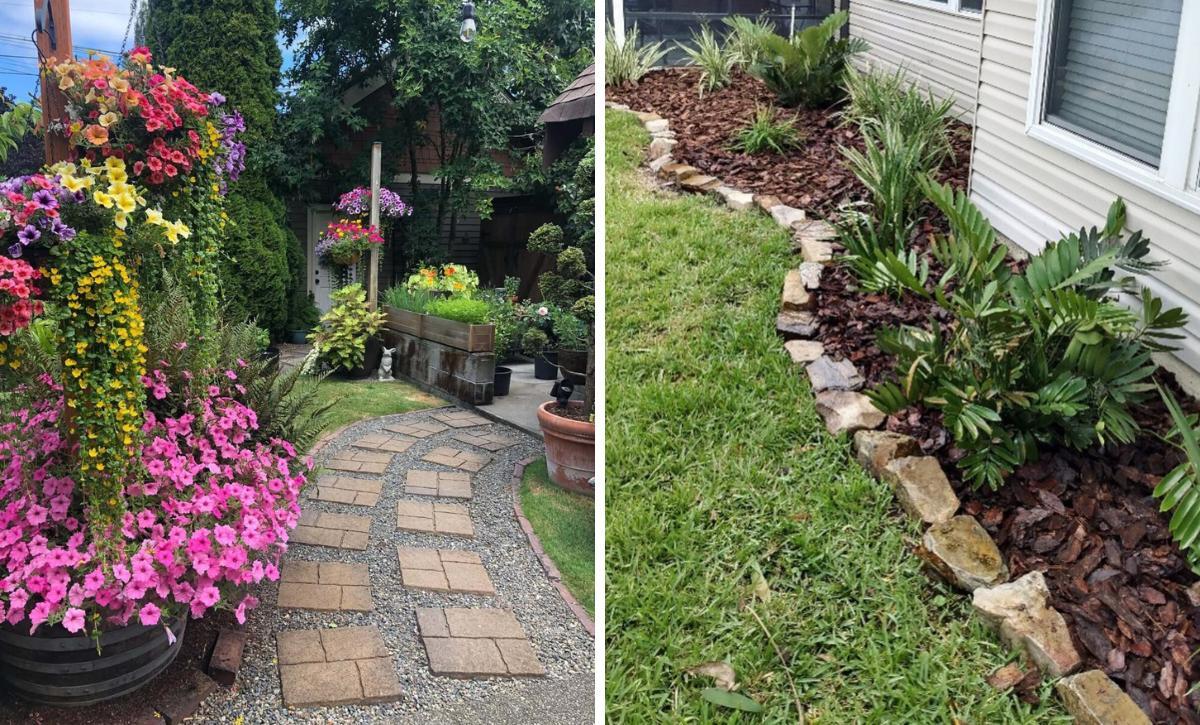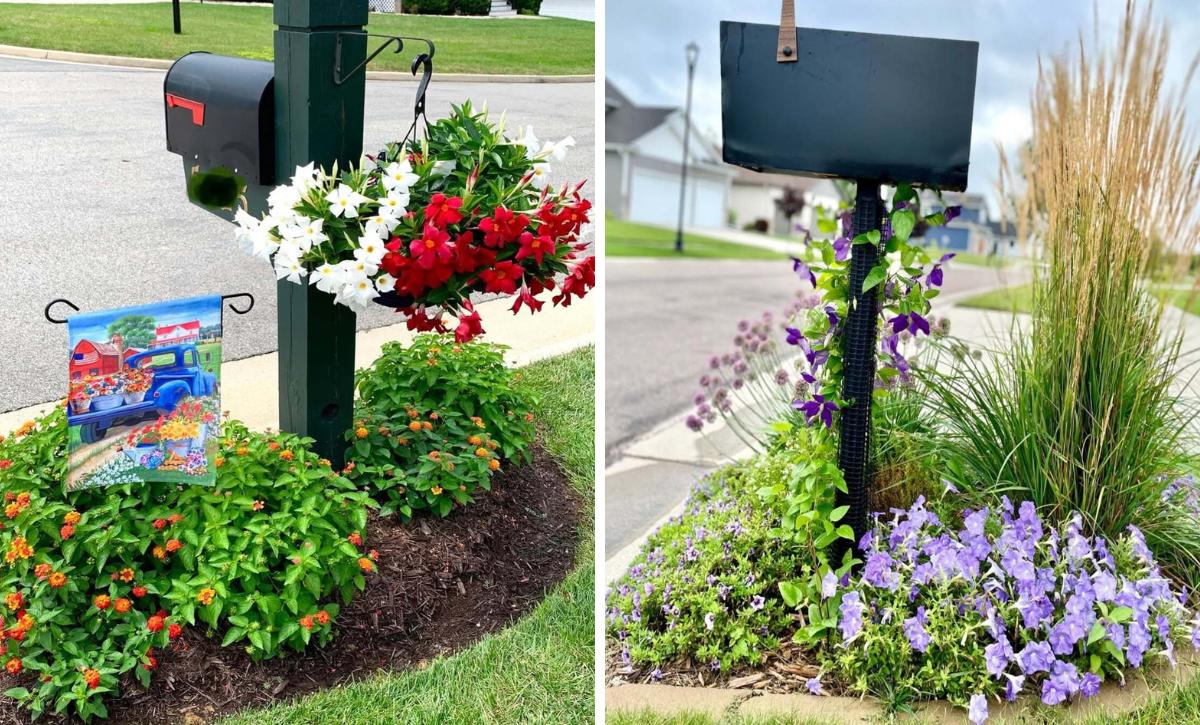Trees play an integral role in our ecosystem, with all the numerous benefits they provide us. However, there comes a time when you have to kill a tree’s roots, and the only option is to use bleach or some other chemical.
For instance, let’s say your sewer line has tree roots in them. There may be a few ways to eliminate them without killing them, but it certainly won’t be worth the effort.
We have written this article to arm you with the knowledge to effectively kill tree stumps and roots. We will look at the pros and cons of each method to give you a chance to choose the best one to get rid of trees and stumps on your landscape.
Killing Tree Roots Using Bleach

Bleach is a common household item that we all know can affect your plants, trees, or even you. We can’t say it’s the most effective method of killing trees, though.
Unlike other herbicides, bleach can’t be effectively absorbed in the tree system. It may get rid of some tree roots, but more mature and resilient trees can regrow new roots and shoots after being damaged.
Bleach will help you eliminate tree roots that have invaded your sewer line. Still, you’ll probably have to repeat the procedure before they’re all dead. Since bleach doesn’t dissolve roots, you’ll still have to remove them manually.
Bleach is also highly corrosive and may react with metal pipes to cause more harm than good, so keep that in mind.
Nonetheless, stronger pipes can withstand bleach, and you can use it to solve your problem. To effectively kill tree roots with bleach, cut them, drill holes in them, and then spray bleach on them.
To minimize damage to surrounding areas, you can use an old paintbrush to paint the drilled sections of the roots. There is no guarantee that this will completely work, and you’ll probably have to repeat the process a couple of times.
Luckily, there are other ways you can kill tree roots other than using bleach. So hang tight and be ready for a new beautiful landscape!
How Long Does It Take For Bleach To Kill A Tree?
A bleach solution with a ratio of 1:1 of bleach and water will make tree leaves dry out within ten minutes after application.
However, as we said earlier, some trees may survive this process. It can take months to get rid of a tree stump, let alone a whole tree. Hence, the alternative (and better option) would be cutting down the tree and removing the stump.
You may not get the desired results with DIY-killing tree solutions.
However, they can effectively eliminate moss on the tarmac and kill other smaller plants. What we’re basically trying to say is that this is a trial and error, so before you meet the handsome prince, you gotta loads of toads to kiss, so to speak.
Can Bleach Harm Trees?
Yes, bleach will definitely harm your trees. So, if you’re not intending to kill your whole tree but only some roots, you’ll have to be very careful with this method.
Chlorine bleach acts as a dehumidifier and causes plant leaf tissue to dry down. Subsequently, tree leaves start to wilt and drop off. So yeah, bleach can cause harm to your tree!
There is some good news, though. You can simply neutralize bleach with water if it comes into contact with the tree bark.
Other Methods Of Killing Tree Roots
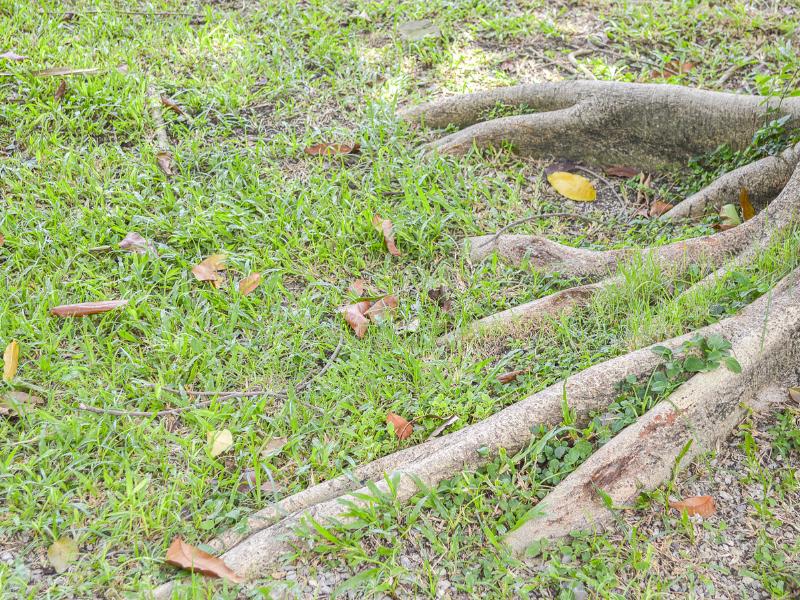
Before you call a specialist, there are a couple of home remedies you can try out.
This section will cover other methods you can employ in eliminating tree roots and their effectiveness.
Epsom Salt
Epsom salt is a naturally occurring compound of sulfur and magnesium, and it’s a common technique used to kill tree roots.
Epsom salt may be harmless to plants in small quantities. However, it can be very destructive to your tree roots in large amounts, which is exactly what we need, right?
Fill a bucket with 11 liters (3 gallons) of water and dilute approximately 3 kg (around 15 cups) of Epsom salt. Reveal the roots by digging around the stump using a trowel. Make holes in the tree roots in all directions using a drill and fill the holes with the solution.
Repeat the procedure until you see the roots start drying out. Wait until the root system is dry before cutting them out or uprooting the whole stump.
For this method to be 100% effective, apply the Epsom salt to the live tissue to reach the root ends.
Rock Salt
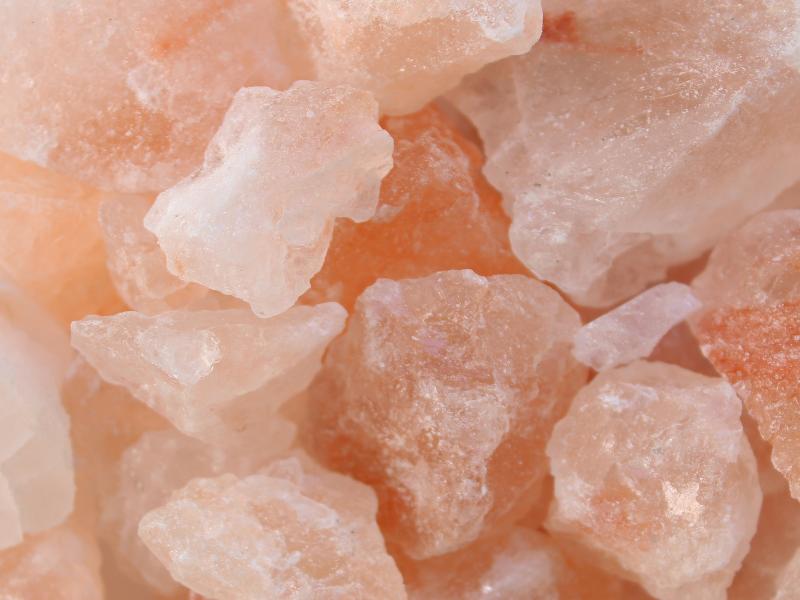
Rock salt is another common method people have purportedly used to effectively kill tree roots. All you need to do is simply flush some bit of rock salt down the toilet, and viola! No more roots!
You will need about 900 grams (2 pounds) of rock salt. However, you aren’t supposed to flush it all at once. It can cause a lot of havoc and damage your tree.
Take 225 grams (half a pound) and flush 2-3 times. Flush the rest of the rock salt afterward. Repeat the process in two weeks to kill any surviving roots in your sewer line.
Copper Sulfate
You may not necessarily have it in your home, but copper sulfate has been proven to be a compound that can destroy tree roots in your sewer line.
It’s also an effective algaecide, herbicide, and fungicide, so you can use it to eliminate almost everything, from weed sprouts and microscopic fungi to tree roots.
All you need to do is pour 159 grams (half a cup) of the copper sulfates into the toilet and flush it several times.
Killing A Tree Stump
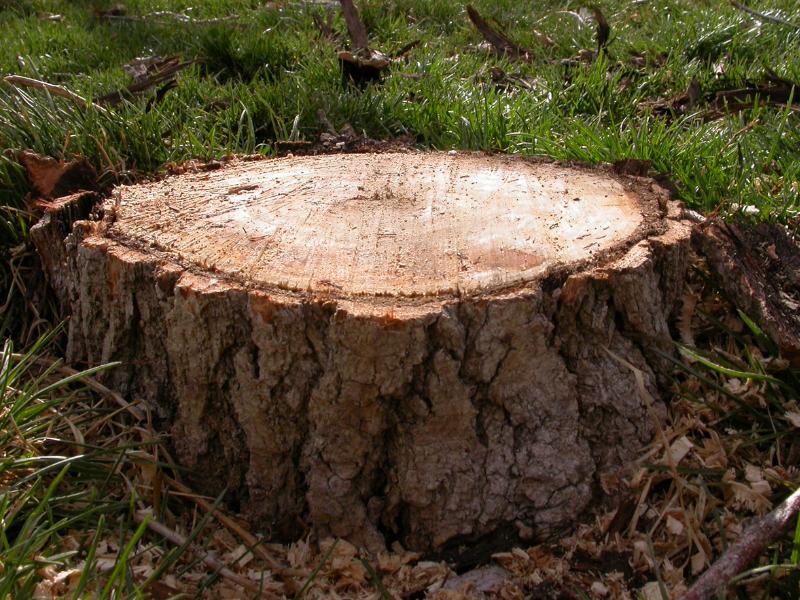
Felling trees is not an uncommon thing. Sometimes trees can shade a lawn and prevent grass from growing as it should or grow too tall and tangled with power cables. However, cutting a tree can leave you with an ugly stump that will only taint your yard.
In this section, we’ll look at techniques you can use to effectively remove tree stumps.
Potassium Nitrate
Potassium nitrate, also known as saltpeter, is one of the most effective methods of removing tree stumps. It usually takes six weeks or a month for you to get results.
You must know how to use this compound to remove your tree stump effectively. First, use a drill bit to drill holes 4 inches deep and apart. Fill the holes with potassium nitrate, pour hot water into them, and wait for the magic to happen.
Speed up the process by covering the stump with mulch if you like. The only downside with potassium nitrate is that it’s very hard to find, so if you find it at your local hardware store or Home Center, don’t hesitate to buy it.
Chemical Herbicide
Herbicides have always proven to be the way to go when dealing with tree stumps. Examples of great stump killers are 50% glyphosate concentrate brush killers and Tordon. Tordon can actually kill your entire tree, let alone your stump!
If, for whatever reason, you need to get rid of a tree below 4.5 meters (15 ft) tall, you can go for systemic herbicides such as Roundup.
These herbicides attack the roots’ ends, disrupting plants’ natural biological processes.
Stump Grinder
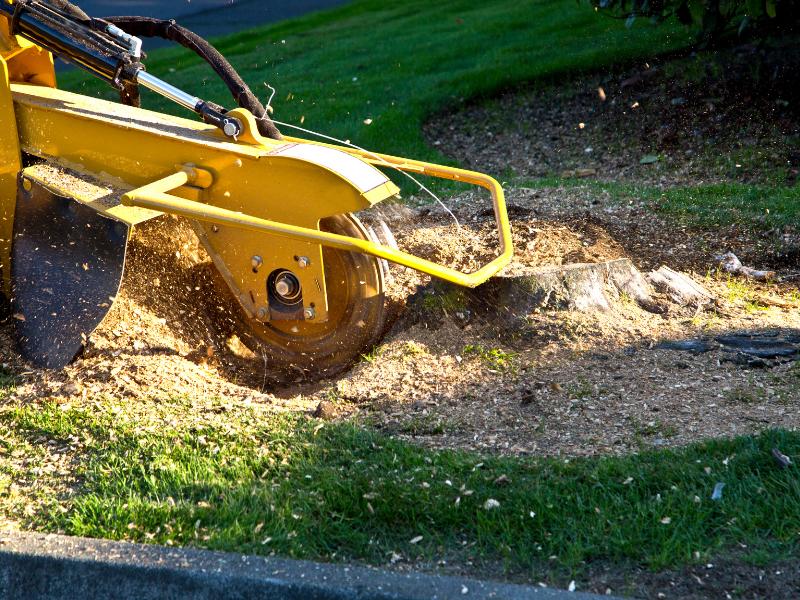
If there are several felled trees in your landscape, then probably the best method is to rent a stump grinder.
However, renting a stump grinder is quite expensive, so we wouldn’t advise this option if you only have one tree stump to remove.
There are two ways you can approach this. You can start attacking the stump to try and pry it out, but this will require great effort and serious muscle. Alternatively, cover the stump with compost and wait for it to dry and rot before uprooting it.
Copper Nails
Yes, that’s right! Copper nails can also be used to kill tree stumps. Even if it sounds hard to believe, the science behind this method actually makes sense.
Hammer some copper nails into the tree stump. The number of nails you need will be determined by the size of the stump. Cover the nails with soil.
The goal here is to oxidize them and enable the release of copper oxides. Copper oxides are very harmful to plants. The procedure might take a while, but it’ll surely restore your landscape to its former glory.
Bleach
To effectively remove a tree stump using bleach, you’ll need to expose the tree’s living tissue. This is because bleach only attacks the weaker sections, such as leaves and the cambium layer.
As such, if you have a tree stump that’s been there for a while, you should drill holes in the outer layer or reveal the live tissue using a chainsaw for better results. Paint the live tissue or fill the holes with bleach and wait for the results.
Wait for new branches to stop emerging from the tree trunk before prying it out. However, if some shoots continue to grow, you probably need to switch it up and go for a stronger herbicide that will take care of your problem.
Frequently Asked Questions
We know that we couldn’t cover all the necessary details in one article, so we took the time to look at some of the most common questions you had for us.
Let’s take a look at them, as well as their answers!
1. Which household products can I use to kill tree roots?
We’ve already covered some household products that can effectively remove tree stumps and roots, like bleach, rock salt, and Epsom salt.
Nonetheless, there are a couple of other household items you can use.
You can use a large, dark bucket or a durable black trash bag to kill tree roots. Cover the tree stump with a black bucket or black trash bag to prevent exposure to moisture or sunlight. Wait for a couple of months, and you’ll start seeing the results.
White vinegar is also another option you can employ, but it might be costly. You’ll need large quantities and frequent spraying for this method to work.
2. How can I permanently kill tree roots?
The fastest and probably the most effective way of killing tree roots and stumps is through chemical herbicides. Some of the best herbicides used are glyphosate and triclopyr. You only need to find the right percentage for your tree stump or root problem.
3. How can I eliminate tree roots in an established garden?
When killing tree roots in a garden, we want to minimize damage to other plants as much as possible. The best way to accomplish this is by drilling holes in the roots or stump and only filling them with chemicals.
This prevents leakage onto other garden plants and protects your flowers. Once you’ve drilled the holes, fill them with a chemical of your choice, be it potassium nitrate or bleach.
Using copper nails hammered into your tree stump is also another effective way of minimizing damage to your surrounding plants.
The method that we highly recommend is covering the tree stump with a black trash bag. This eliminates the use of harmful chemicals that may cause damage to other plants.
Also, keep in mind that rock salts and Epsom can leach into the soil and cause a lot of harm, so be very careful when using them.
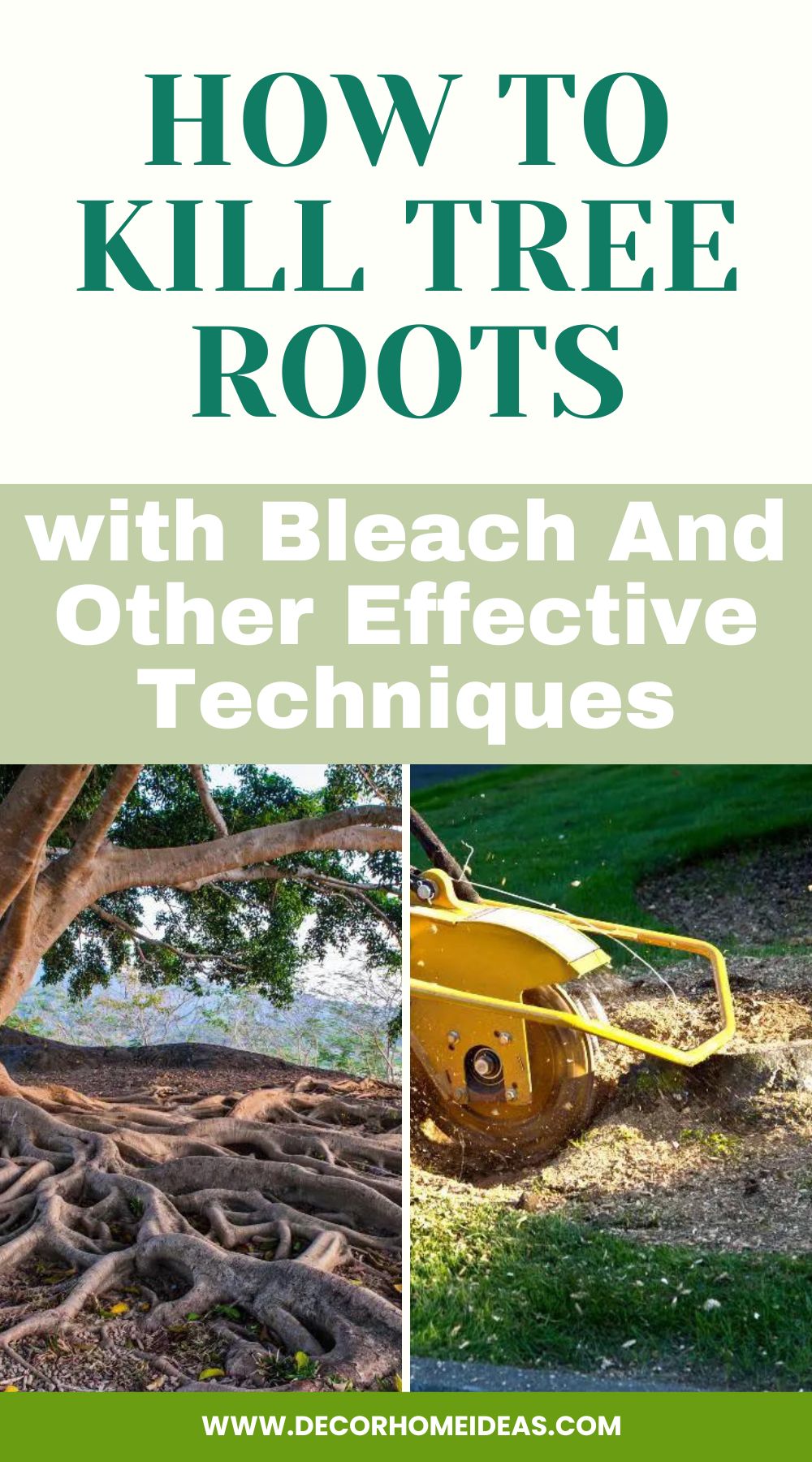
Final Remarks
The purpose of this article was to provide you with the relevant information on how to kill tree roots with bleach, but we’ve also covered some various effective methods of eliminating tree roots and even stumps.
Most of these techniques require you to drill holes and much patience before you see any results (except maybe for the stump grinder).
Be careful when using herbicides and other chemicals to kill tree roots and stumps since they can potentially harm surrounding plants. You also need to control the chemicals you use when removing tree roots in your sewer line to avoid killing your whole tree.
We hope you’ve had a good reading and that these tips will help you journey to a complete stump or root-free landscape! Good luck!

